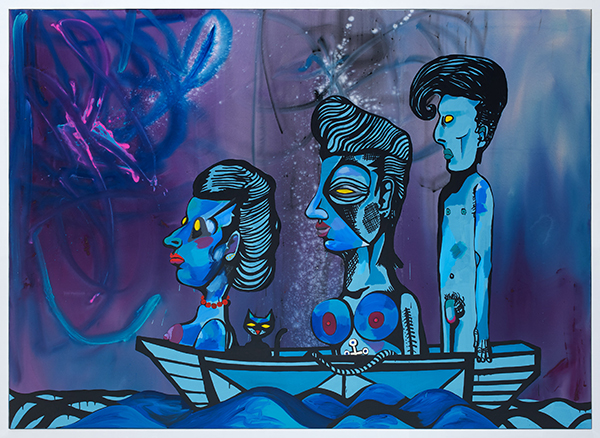Like a modern-day Ishmael, Steven Hull spent the last few years sailing and seeing the watery part of the world. Hull’s enthusiasm for his new hobby unmistakably influenced his current exhibition of painting, sculpture and sound installation at Rosamund Felsen. The nautical and the carnivalesque, two fitting bedfellows in their evocative and lonely surrealism, dialogue with each other in Hull’s work; he contrasts the sense of adventure and whimsy commonly associated with both milieus with the melancholy and anonymity that are perhaps even more pervasive.
The wood sculptures, such as Wow! Wow! Wow! Wow! Wow! Wow! Unbelievable! (2015-16) and Watching Every Night (2014), embody a childlike enthusiasm for sailing and the sea. The former is a glass vitrine with an orange sailboat perched atop rough-cut black and white waves; two incongruous globular pink breasts heighten the piece’s humor. The latter is a sculpture of a boat, roughly the size of a car and painted in monochromatic gray; its smooth, simplified design and the inclusion of waves at its base are quaintly charming. Near the sculptures is a large abstract painting, subtly gridded like a windowpane and painted in watercolor hues of scarlet, gold and ocean blue; it is the most straightforwardly beautiful piece, evoking sun and sea.

Steven Hull, Is the Moon Bright Enough? 2015, 2015-16, photo by Grant Mudford, 2016.
Despite these whimsical touches, including strands of nautical lightbulbs hanging from the rafters and calliope music filtering through the gallery, most of Hull’s work attests to the darker side of life at sea and on shore. Five oil and ink works render their subjects—a couple getting married, a man with his head buried between a prostitute’s thighs, and a solemn young girl—in cubist angles with oversized, primitive features à la Picasso. The gloomy palette—thin black lines and smoky smudges—and obscured visages impart a sense of profound alienation.
The several large figurative paintings certainly don’t shy away from color or bold mark-making, but they are equally glum. Picasso and Max Beckmann are clear references in Is the Moon Bright Enough? (2015), which features three morose naked figures in a small dinghy, the whole work rendered in shades of moody blue. In I Don’t Want to Go (2015), a man in a fuchsia clown suit moves to grab the thigh of a woman painted in lurid green and naked except for fishnet stockings. And in With Your Hemlock on the Rocks (2015) a masked man shoots sparks out of his hand at the back of a pathetic drooping figure with a flaccid penis, straight out of Kippenberger’s work. Hull’s figures are always masked, whether literally or through the artist’s obfuscating marks. They are estranged and alone, occasionally mitigating this through sex, violence or the abysses of daydreams.
The sea, where people commonly go to feel alive, and the carnival, intended to delight the senses and engage one’s curiosity, are revealed by Hull to be much more complicated places. Below deck and behind the curtain, Hull unveils humanity’s outcasts, attempting to find meaning amidst the roar and the revel.


